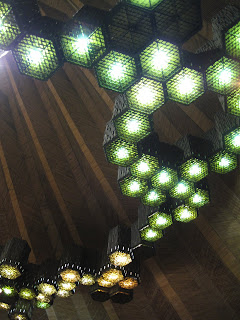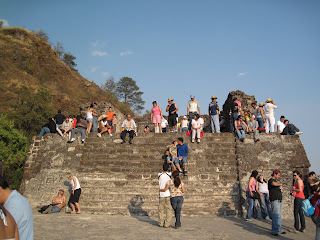Wednesday, April 29, 2009
Mientras la ciudad esperaba....
And the world wasn't listening
only waiting
with us
Hearing the sound of always open doors sudden shut tight
too late no se
Not a land, not some dirt, but a culture
paralized, altered, evolved
with no mouths and kissing from the feet
He was waiting
wearing his hands away with disinfectant
poisined from the constant mercury
in his waiting mouth
Wait and see no se
no see when the eyes are covered too
a war against your neighbor
breeds bad energy, bad cells
sabes Senor?
get sick get well hang around oil wells
we don't say anything
but wait and see wait and se
Monday, April 20, 2009
La Villa (where our Lady is in the house)
 Although the colonial churches in the rest of Mexico City are usually underwhelming, La Villa boasts the best collection of them in the Distrito Federal. For example, the Capilla de Pocito, below.
Although the colonial churches in the rest of Mexico City are usually underwhelming, La Villa boasts the best collection of them in the Distrito Federal. For example, the Capilla de Pocito, below. La Capilla de Cerrito is at the peak of the deceptively long stairway leading to the summit of Tepeyac. This is where Juan Diego saw and spoke with the Virgin. Unfortunately, while I saw the doors were wide open when I was standing in the plaza below, by the time I had climbed the few hundred odd steps it was closed.
La Capilla de Cerrito is at the peak of the deceptively long stairway leading to the summit of Tepeyac. This is where Juan Diego saw and spoke with the Virgin. Unfortunately, while I saw the doors were wide open when I was standing in the plaza below, by the time I had climbed the few hundred odd steps it was closed. Yet my efforts were not in vain: the crest of Tepeyac offers one of the better views on the valley of Mexico. It happened to be one of the rare cloudy days of spring, and sunset to boot, but all the telltale signs of the vast yet limited bowl which some two dozen million call home were laid out clearly to the south, east, and west.
Yet my efforts were not in vain: the crest of Tepeyac offers one of the better views on the valley of Mexico. It happened to be one of the rare cloudy days of spring, and sunset to boot, but all the telltale signs of the vast yet limited bowl which some two dozen million call home were laid out clearly to the south, east, and west.
Ramírez Vázquez has left a considerable imprint on the capital (see the Museo de Anthropologia in my previous entry 'A Walk In The Park (El Bosque de Chapultepec)', for instance). His Basilica is a feat of both engineering and democratiziation of clerical space. The roof is suspended from a central spine, and it's underside is finished in a warm, inviting wood. This structural solution frees the space of columns and allows maximum, equal visibility of the altar, and the ORIGINAL tilma of Juan Diego which is also mounted on the central spine (if you are unfamiliar with the story of Juan Diego and his rosy tilma, look here). As much as I realize the fallacy of my tendency to make arbitrary comparisons, once inside the bascilica, I could not resist the suggestion that Ramírez Vázquez was perhaps making a three dimensional reality of a ubiquitous abstract theme from the renaissance. Take for instance, Piero della Francesca's Madonna of Mercy. While the faces inside the bascilica look different, they are every bit as devoted to Our Lady, and considering the emphasis placed on suffering in Mexican religious tradition, just as needful of her enveloping mercy as well.
As much as I realize the fallacy of my tendency to make arbitrary comparisons, once inside the bascilica, I could not resist the suggestion that Ramírez Vázquez was perhaps making a three dimensional reality of a ubiquitous abstract theme from the renaissance. Take for instance, Piero della Francesca's Madonna of Mercy. While the faces inside the bascilica look different, they are every bit as devoted to Our Lady, and considering the emphasis placed on suffering in Mexican religious tradition, just as needful of her enveloping mercy as well.
 Despite these antique references, the place is not without it's uniquely modern curios. So great is the flux of visitors to the basilica that there is a sloping path tucked behind and beneath the altar to accomoadate the demand to gaze at the tilma without interupting the mass.
Despite these antique references, the place is not without it's uniquely modern curios. So great is the flux of visitors to the basilica that there is a sloping path tucked behind and beneath the altar to accomoadate the demand to gaze at the tilma without interupting the mass. Seeing the image of Our Lady all over Mexico, in addition to an increasing presence in the United States and elsewhere, zapped much of the aura from seeing the real deal. It doesn't look any different from the same image of adoration present in every church in this country. Nor is it strikingly different from various images of the Virgin and puti from contemporary Europe, but for the fact that her skin is of a slightly darker tone.
Seeing the image of Our Lady all over Mexico, in addition to an increasing presence in the United States and elsewhere, zapped much of the aura from seeing the real deal. It doesn't look any different from the same image of adoration present in every church in this country. Nor is it strikingly different from various images of the Virgin and puti from contemporary Europe, but for the fact that her skin is of a slightly darker tone. I found more impressive the framing, the introduction of airport technology into sacred space (i.e. people movers), and, as usual at such places, the mob's obsession with taking the experience away with them. Truly, even in a church, the aura of art can be dispersed to non-existence.
I found more impressive the framing, the introduction of airport technology into sacred space (i.e. people movers), and, as usual at such places, the mob's obsession with taking the experience away with them. Truly, even in a church, the aura of art can be dispersed to non-existence.


 Adios.
Adios. Monday, April 13, 2009
Tepotzlan


 BUT, the town is famous for its little late Aztec era pyramid pearched atop the edge of the valley. If you look closely at the image below, you can just make out the tell tale straight lines of human intervention on the ridgeline.
BUT, the town is famous for its little late Aztec era pyramid pearched atop the edge of the valley. If you look closely at the image below, you can just make out the tell tale straight lines of human intervention on the ridgeline.



 And the spirits (as well as a lot of tourists) can look down on the places where modern man prefers to dwell.
And the spirits (as well as a lot of tourists) can look down on the places where modern man prefers to dwell.